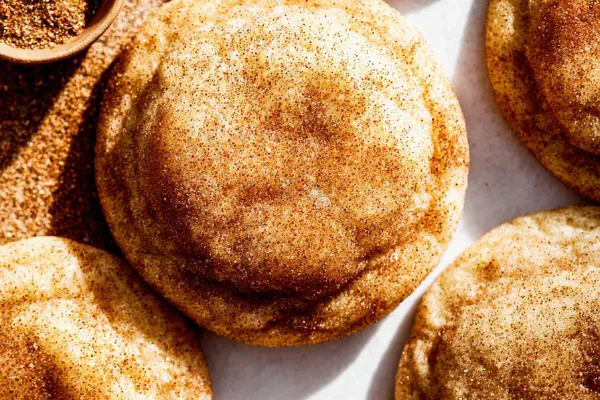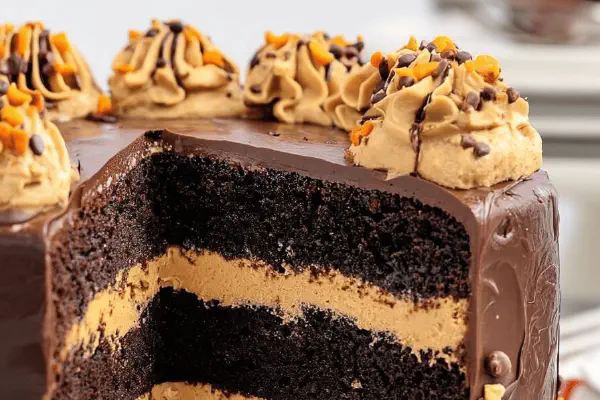Snickerdoodle Cookies Twist

E
By Emma
Certified Culinary Professional
•
Recipe tested & approved
Snickerdoodles reworked with a hint of browned butter and a pinch of cardamom added to the cinnamon sugar. Made with butter instead of shortening for depth. Powdered cream of tartar cut by 5% for balance. Flour increased slightly to stiffen dough just right. Baked at 380F for 9 minutes, shorter if edges brown too fast. Dough slightly sticky but workable chilled or warm. Watch for puff-out, slight crackle on top, not browned. Let rest just 90 seconds before cooling on rack. Learned from trial and error to avoid flat, greasy messes and underwhelming spice. Rolls nicely, smells nutty, with cardamom adding faint citrus warmth behind cinnamon hit.
Prep:
22 min
Cook:
9 min
Total:
31 min
Servings:
22 cookies
#American Cookies
#Browned Butter
#Spiced Cookies
#Chewy Cookies
#Baking Tips
#Cookie Coating
Snickerdoodles—more than cinnamon sugar balls, if you pay attention. Browned butter? Yes, skip shortening, get nuttiness that sticks with you. Tried it all—shortening, butter, margarine—standard way leaves bland taste and wrong chew. Cream of tartar reduced slightly, keeps tang without weird aftertaste. Toss in cardamom with cinnamon. Weird but trust me, magic happens. Dough feels sticky sometimes, but chilling fixes that. Baking time? Watch edges and cracks not clock. They puff, crackle, then settle chewy, soft but hold their shape just right. You want aroma like warm spice market, not just sweet sugar. Might get messy rolling but rolling in spice sugar twice gives top that addictive crunch. Learned the hard way to space dough balls well or cookies spread into sad pancakes. No cheating on that step. This is a cookie for hands-on cooks who listen to dough and oven.
Ingredients
- 2 ½ cups all-purpose flour
- 1 ½ tsp cream of tartar (reduced from 1 ¾ tsp)
- ½ tsp baking soda
- ½ tsp fine salt
- 12 tbsp unsalted butter browned until nutty aroma, cooled
- 1 cup granulated sugar
- ⅓ cup packed light brown sugar
- 2 large eggs
- 1 tbsp pure vanilla extract
- For coating
- ⅓ cup granulated sugar
- 1 tbsp ground cinnamon
- ½ tsp ground cardamom (added twist)
About the ingredients
Brown the butter. It takes minutes but doubles flavor grit. Don’t skip cooling the butter or you’ll scramble eggs in mixing. Reducing cream of tartar by 5% cuts overly tangy bite without losing chew factor. Flour bumped up a touch to combat extra moisture from butter swap. Cinnamon with cardamom upgrade adds complexity, but keep cardamom light, easily overpowers. Substitute lemon juice plus baking powder if no cream of tartar nearby. Regular granulated sugar in cookie plus more cinnamon-sugar blend outside—both critical for texture and crust contrast. Holding dough back for chill helps weather sticky seasons or hot kitchens. If sticky even after chilling, dust with flour sparingly each time you roll. Packing sugars properly ensures even sweetness—brown sugar packed tight, granulated loosely. Play mix times to not overwork eggs or flour lumps form. Stand mixer paddle crucial or mix gets greasy hands mess. The spatula for folding saves gluten from toughening. Keep cinnamon-sugar mix ready before scooping—no extra steps mid rush and coating cool dough can dull flavor release.
Method
- Start preheating oven at 380°F. Line baking sheets with parchment paper or silicone mats. No clouds; even heat needed.
- Sift flour, cream of tartar, salt, baking soda together. Airy mix avoids dense cookies—your base.
- Brown butter first—use medium heat, swirl pan, watch for golden brown specks and smell change. Don’t burn. Let cool to warm, not cold, or mix will seize.
- Mix sugars and browned butter in stand mixer with paddle attachment. Cream for around 3 minutes. Scrape sides a couple times. Your mix should look velvety, fluffy. Shortening skipped here to boost flavor but be ready, dough is denser.
- Add eggs one at a time, then vanilla. Mix just until no streaks. Overbeating eggs breaks dough texture; be gentle.
- Turn mixer off. Fold dry ingredients into wet with spatula. Stop as soon as flour disappears. Overmixing means toughness—scrap that.
- If dough’s sticky and too soft to handle, chill 15 to 20 minutes or dust hands lightly with flour. Avoid excess flour or cookies get dry.
- Combine coating sugar, cinnamon, cardamom in small bowl. Cardamom gives that faint spice kick — trust me, subtle but noticeable mid-bite.
- Scoop dough with 2-tablespoon measure. Roll quickly into balls. Roll in spice sugar coating. Don’t skimp on coating - integrity of snickerdoodle is in that crackly, sugary crust.
- Arrange balls on sheet, 6 per tray max, spaced well so they don’t merge. Crowding means spread-out flat circles, no chew or chew-tough ratio.
- Watch them closely baking 8-10 minutes at 380°F. Edges should firm up and just turn light gold, tops puffy and cracked but no brown spots. Underbaked raw dough sheen gone but interiors still soft.
- The moment cookies come out, treat them gently. They’ll feel super soft, fragile even. Cool one minute right on pan to settle. Then onto rack to cool fully, not plastic or moisture traps. The cookies' structure firms gradually; patience here is key.
- Best enjoyed once just cooled but slightly warm—chew is tender, sugar crackle evident, cardamom lingers faintly.
- If you can’t find cream of tartar, use 1 tsp lemon juice plus ¼ tsp baking powder as backup, but expect slightly different texture.
- Butter can be swapped for coconut oil for dairy-free adaptation. Keep in mind dough softens more quickly—chill longer before rolling.
- For dry, cracked sides, too much sugar or overbaking likely culprit. For flat, oily spread, chill dough longer or reduce butter by a tablespoon.
- This method taught me: browned butter transforms snickerdoodles from just sugar and tartar combo to something nuttier and layered. Cardamom adds unexpected warmth that cuts through sweet monotony.
- Master cookie texture by ignoring exact time on timer—look for puff-top cracks and barely tan edges, not color alone. Mesmerizing to watch them rise then cool into chewy clouds.
Cooking tips
Start by preheating hotter than usual to compensate for browning butter moisture and get good rise without flattening. Sifting dry avoids dense spots and creates even lift. Creaming browned butter with sugars adapts moisture well, fluffy before eggs hit. Add eggs slow, combining only till no streaks—over mix ruins texture subtlety. Folding instead of mixing ensures tender crumb. Sticky dough means chill time, don’t fight it or you’ll end up with spread mess. Roll fast and firmly but gentle enough to keep shape. Rollers doubled in spice sugar mix lock in flavor clouds, crunch top. Space dough well—at least 3 inches apart—cookies jump. Bake sweet spots 9 minutes or slightly less, watch edges, no brown spots. Remove cookies soft and puffy, they’ll firm up gradually. Cool on pan 60–90 seconds, then shift to rack or bottoms get steamed soggy. Patience cool needed; hot cookies fragility biggest cause of breakage. Serve warm or cooled—both great, slightly different textures. Baking sheet crowding is common rookie error—cookies spread and merge turning slabs. Rolling dough balls too long makes hands hot, melts butter, tough cookies. Keep scissors or second scoop handy to keep size consistent. Don’t trust timers blindly: cookies speak to you. Listen for crackly tops, faint aromatic spice, edge color shifts. That’s when take ’em out.
Chef's notes
- 💡 Preheat oven hotter than usual, 380F, compensates moisture from butter browning. Look for puff-top cracks not color alone. Cookies firm on edges, just lighten gold tops. Remove early if edges brown too fast. Cool 60-90 seconds on pan, then rack to avoid soggy bottoms. Patience here, cookies firm gradually, fragile at first.
- 💡 Brown butter medium heat, swirl pan. Watch carefully. Golden specks appear, nutty aroma hits. Don’t burn or bitterness comes. Cool to warm, not cold to avoid scrambling eggs. Mixing warm butter crucial, keeps dough workable, stops seizing. Skipping steps messes up texture.
- 💡 Fold dry ingredients with spatula instead of mixer. Stop mixing on first flour disappearance. Overmix makes tough cookies, no chew, no crack. Chilled dough easier to handle if sticky; dust hands lightly with flour but don’t overdo. Dusting excess flour dries cookies out.
- 💡 Coating blend needs prep before scooping: sugar, cinnamon, cardamom. Cardamom light; too much steals cinnamon spotlight, overwhelms. Roll dough balls fast, then coat twice helps crunch. Size consistency essential; use 2-tablespoon scoop. Roll balls quick, dough warms fast, melts butter leading to greasy spread if lingering too long in hands.
- 💡 Substitute lemon juice plus baking powder if cream of tartar missing—expect different texture, less tang but still chew. Coconut oil works for dairy-free but dough softens fast; chill longer before rolling. Sugar packing matters: brown sugar tight, granulated loose to keep balance and structure intact.
Common questions
Why brown butter?
Adds nutty aroma, deeper flavor, changes moisture. Butter browns at medium heat, watch for specks. Cool before mixing. No brown = bland dough.
How to know when cookies done?
Look for puffed top with tiny cracks, edges light gold not brown. Center soft but no raw sheen. Timing varies, watch closely 8-10 minutes most common window.
Dough too sticky?
Chill 15-20 mins. If still sticky, dust hands with flour sparingly. Avoid overflouring or cookies dry out. Hot kitchens mess dough consistency, chill helps temp control.
Can I store baked cookies?
Store airtight at room temp few days. Rack cool fully first. Freeze in airtight container for weeks. Dough balls freeze well too; thaw and roll in coating before baking.



